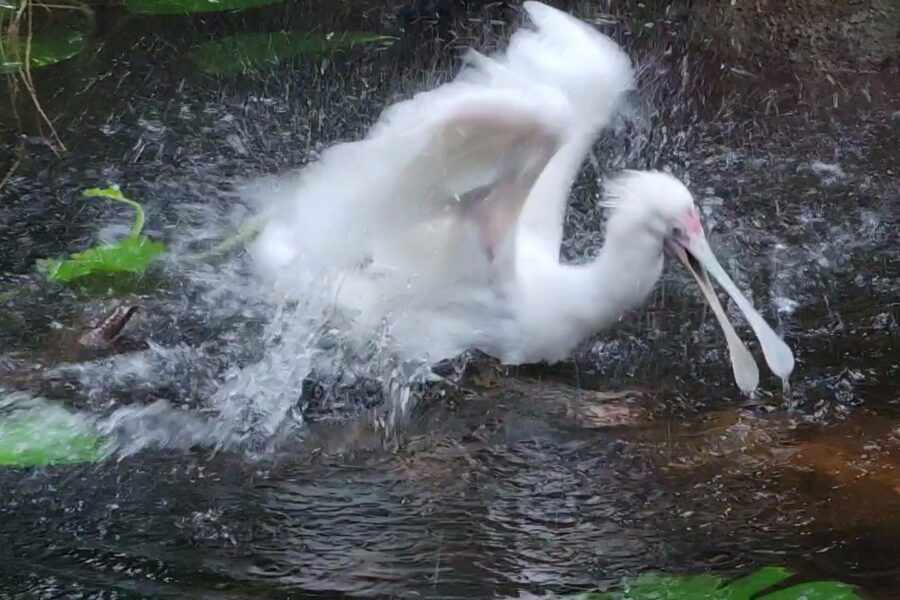Rainforests
We wake to a cold day. A rainy day. A good day for an inside activity. We agree that a day in the Moody Gardens Rainforest Pyramid would be a wise choice.
I have only been to a rainforest once, and that was in Puerto Rico on a warm December day decades ago. The thing that left an indelible imprint on my memory was the size of things. The leaves of all the plants were nothing less than massive in comparison to what I was familiar with, and the bamboo stalks were so large I couldn’t get my hand around them.

There are ten major rainforests in the world and three of the largest are: the Amazon, the Congos, the Australian realm — includes New Guinea and northeastern Australia.
Moody Gardens Rainforest Pyramid
Of course, we dawdle – or rather, I dawdle – and we arrive at the Moody Gardens Rainforest in the early afternoon. Since we don’t have a map, only our noses to guide us, we take the long way around to reach the entrance, making several wrong assumptions along the way.
When we finally find the correct door, before entering the giant terrarium, we walk through a wide dimly lit hallway where we are treated to a symphony of forest sounds. There are signs urging silence and that tell us to stop and listen. Small enclosed exhibits of hidden forest creatures punctuate our path.
As we near the main event, we see words painted on the wall that could be my daughter’s words but are instead those of a Kenyan Proverb.
Treat the Earth well. It was not given to you by your parents. It was loaned to you by your children.
Kenyan Proverb



We open a set of double doors and are given a choice – an elevator or stairs. I follow Michael up too many steps to the top of the Moody Gardens Rainforest. We begin our safari among the treetops of the rainforest pyramid, immediately discovering it is more a game of hide and seek rather than sitting, seeing, and observing for long periods of time. We see green. Green is everywhere. Trees. Tropical plants. Vines.
Unseen birds sing a quiet, friendly tune. I lose Michael when I am distracted by flashes of color far below. I stand, camera in hand, waiting for the streaks of brilliant vermillion to take form.





Birds in the Rainforest
Not long into our exploratory trek, the light chirping from our feathered friends breaks into a cacophony of chaos. Even one of the attendants tells us she is unsure what got the birds so riled up. But soon, the seeming panic dies down to a low murmur.
At times, we are lucky, and the rainforest inhabitants stand still, almost posing for a picture. However, more often than not, we have to pay strict attention to what is below and above, constantly searching for glimpse of color and rustling leaves as we wind our way down to the floor of the pyramid.




South American parrot, South American scarlet ibis, New Guinea western crowned pigeon, and a beautiful bird that flew to the highest branch of the tree to check us out, but did not tell us its name.
We dressed for the cold outside, and we’re discovering that was a big mistake. It is tropically warm in here. We continue shedding our outer clothing, trying to figure out what to do with our cumbersome load. We sling jackets over our shoulders, tie them around our waist and carry them over our arms. Giving up, we put our jackets back on, only to remove them again.
Monkeys and Bats
As we continue our curving path downward, we stop and talk to a rainforest volunteer. She points out the unusual saki monkey sitting on a railing nearby. He’s a youngster, and he does look monkey-like with his tiny face, but his body is too fluffy. His tail, too long and bushy. His female counterpart comes to visit. She is a very old twenty-five. She looks old – her fur, wiry and graying. We are told most sakis only live fourteen years in their natural habitat. However, those held in captivity can live to be as old as thirty-six.
Behind a screen, a bevy of fruit bats hanging by their feet are continually in motion. From here, it is hard to tell if they are playing or fighting.



Male saki monkey, female saki monkey, fruit bats.
Once we reach the floor of the pyramid, we are in a tropical jungle. There is water and waterfalls, fauna and flora everywhere. Behind a glass wall, an ocelot leaves his high perch, making his way down to the ground to retrieve his lunch. “It’s a dead rat,” Michael says.
We pass by many things not visible from above. Parrots and ruined temples and fish and signs that say DO NOT PUT YOUR HANDS IN THE WATER.



We see the forest at night and are led through a cloud forest. Eventually we wind up in an area of poisonous creatures that slither and crawl and fly and hop. Vipers. Vampire bats. Tiny yellow-striped black poisonous frogs.


Sitting in the large visitor center lobby, while waiting for a film to begin, I check to see how many species live in the Moody Gardens Rainforest – we missed a lot. We may need to get better glasses. Maybe binoculars.
As you enter through a tree-top canopy entrance, you’ll visit the rainforests of Asia, Africa and the Americas in a rare, up-close and interactive adventure with over 1,700 exotic plants and endangered animals that range from Giant Amazon River Otters to an ocelot, Komodo dragons and other reptiles. Saki monkeys, Cotton-top tamarins, and sloths roam freely while an array of birds fly between the trees as you walk the trails through the spacious enclosure!
Moody Gardens Website
List of Moody Gardens Species in April 2022.
Apparently we need to return, but next time we will leave our jackets in the car.
To read about Moody Gardens Aquarium check out the following post.









Leave a Reply
Your email is safe with us.